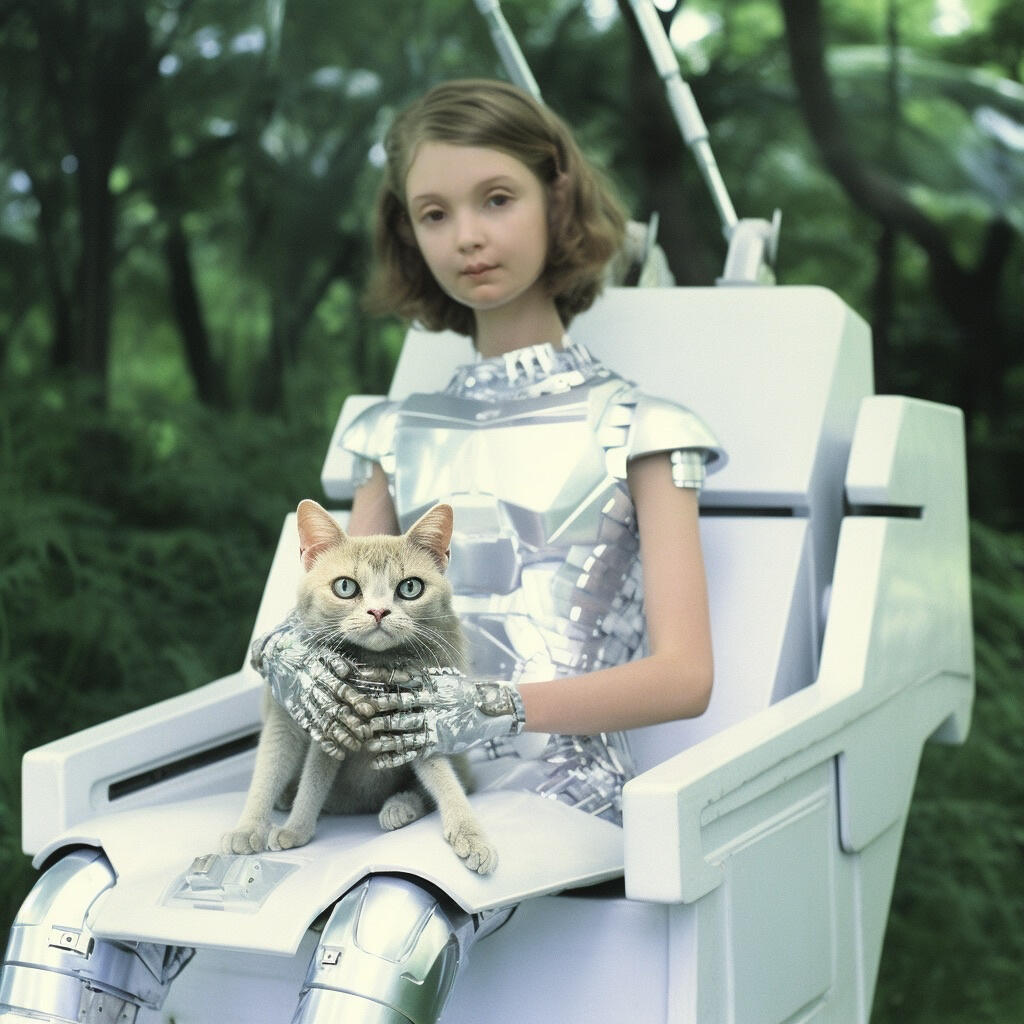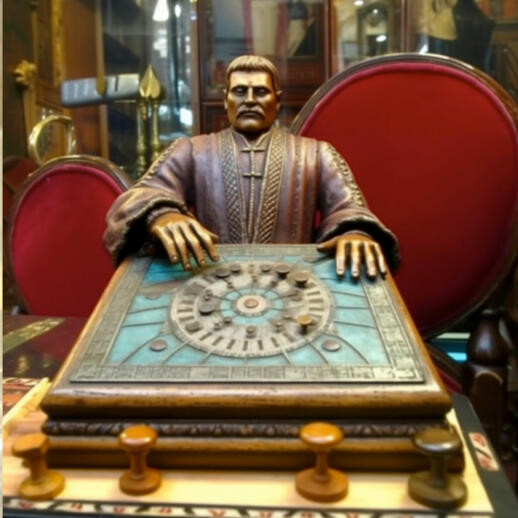
Relationships between artificial and non-artificial lifeforms tend to be very polarized.On one hand, we have the techno-utopians who argue fervently that historical relations characterized by exploitation and dominance can be materially rectified by means of technological progress.On the opposite end of the spectrum, we find the techno-pessimists, a group frequently depicted in popular dystopian narratives such as Terminator, The Matrix and Black Mirror. This category includes eco-feminists, romantic nationalists, Western Buddhists, green anarchists, anarcho-primitivists, and individuals who are still not aware that Henry Thoreau, the infamous last American hermit, had his mother washing his clothes all along.However, today, I aim to follow the carnivalesque tradition and offer a momentary respite from the rationality of everyday life. We'll explore instances where the boundaries between humans and machines have intentionally been blurred or dismantled.In short, I'll be presenting uncanny relationships between humans and machines. But before we proceed, let's first explore the concept of the Uncanny.Frequently, we refer to the "uncanny valley," a theory proposed by the roboticist Masahiro Mori. According to this theory, as a robot or artificial entity becomes more human-like in appearance and behavior, humans tend to experience a growing sense of empathy toward them. However, there exists a critical threshold at which even slight imperfections or discrepancies between the machine and a real human can trigger feelings of unease, revulsion, or discomfort. This point of maximum emotional response is what we call the "uncanny valley."The term "uncanny" was originally coined by Sigmund Freud, who used it to describe an "intellectual uncertainty" towards figures that could either be automated or alive. Freud emphasized the eerie lifelikeness of waxwork figures, hyper-realistic dolls, and automata. Yet, he also emphasized the unsettling machine-like movements exhibited by conditions such as epileptic seizures, manifestations of insanity or hysteria in human subjects. According to Freud, alienated humans could easily trigger this feeling of uncanniness.Hence, contrary to popular belief, humans acting like machines can also evoke an uncanny feeling. In fact, as Julia Park points out in her work "The Self and It," mimetic objects, including artificial life forms, serve as vital tools for comprehending the modern self. These objects and their narratives have jointly shaped our perception of our bodies, minds, and society at large.We will explore some of these stories and relationships that can serve as templates for radical alliances between contemporary digital workers—many of whom may be present here—and artificial intelligence.As an experimental demonstration of these relationships, I have harnessed AI tools to allow certain artificial life forms to express themselves.
Francine Descartes
The initial uncanny relationship I'd like to explore might just be one of the most influential love stories in the Western world.René Descartes, a French philosopher who lived in the 17th century, occupies a pivotal place in the history of thought. His Discours de la Méthode famously marked the beginning of rationalist thinking, modern objectivity, and the positive sciences.
Among Descartes' most celebrated yet contentious ideas was his proposition that the he corporeal world should be regarded as a device that operates under mechanistic principles.He contended that the mind, or consciousness, existed as a distinct entity separate from the physical body. According to him, humans were akin to machines, possessed of an immaterial soul.Many scholars have scrutinized the limitations of this dualistic theory. The division of the world into two distinct substances—the spiritual and the corporeal—inevitably led to the elevation of the former over the latter. This division created a hierarchical relationship, with the mind occupying a lofty position while reducing the body to a mere vessel or machine.
In short, since Descartes, the material, non-thinking entities were presumed to be governed by rational minds. Thinking humans were not to be confused with automated tools.Descartes' rationalist approach and mechanistic views faced substantial criticism. For instance, Susan Bordo argued that Descartes triggered the masculinization of thought, Nicole Merchant contended that he initiated the conceptual and litteral death of Nature, and Gilbert Ryle claimed that he propagated a dogma that led humans to perceive themselves as ghosts trapped in a machine.However, the relationship between Descartes and his daughter, Francine, offers a different perspective.Before being recognized as the father of modern Western philosophy, Descartes was, first and foremost, the father of Francine.
The story of doll Francine ends on a boat.During a voyage across the Holland Sea in the early 1640s, an incident occured. While Descartes slumbered, the ship's captain, harboring suspicions about the contents of Francine's trunk, secretly entered the cabin and pried it open. To his shock, he unearthed a mechanical creature nestled within, which he forcefully extracted from the trunk. He then dragged it across the decks before ultimately casting it into the water.This incident sheds light on the unsettling, or rather the uncanny, reaction that many experience when confronted with the concept of a body devoid of a soul—a being composed entirely of physical matter, yet displaying human-like actions.But if we think about it, this reaction is concerning, especially considering the prevailing scientific consensus that contradicts Descartes' viewpoint. According to modern cognitive science, we lack ethereal souls; we are material beings. Our consciousness is the byproduct of a fully material brain.According to modern science, much like Francine, we are Descartes' babies.Therefore, it becomes evident that when we fear soulless matter and artificial life, what we are truly apprehensive about is not so much the monstrosity of the lifeless object itself, but rather the suppressed doubt that we ourselves may have been reduced to mere objects.In reality, there have been instances throughout history where humans have been treated as soulless matter. One might argue that, at a deeper level, it's not the object itself that terrifies us, but rather the violence that stems from devaluing the body over the mind.In this light, as Francine suggested, it might be acceptable to embrace the peculiarity of seeing ourselves within machines and other forms of artificial life. Perhaps these entities can reciprocate by illuminating the ways in which we sometimes exhibit machine-like qualities more than they do.
Polichinelle Nodier
Happily, this second relationship is heeding Francine's advice. Allow me to introduce you to the alliance between a French writer, Charles Nodier, and his puppet alter-ego, Polichinelle.In the 19th century, puppet theaters often served as symbolic spaces for critically examining social relations. Puppets were regarded as a secure medium for expressing controversial political critique without the fear of censorship. This art form enjoyed greater popularity and accessibility than traditional theatrical performances, thus becoming a reflection of politics and the relationship between rulers and the people, especially among the working classes.In several short stories, Charles Nodier delights in reminding us that it's the actors who imitate the puppets, not the other way around. To be more precise, in Antiquity, statues imitate gods, puppets imitate statues, and actors imitate puppets.Growing up during the French Revolution and its aftermath, Nodier's political views oscillated between praising the revolution and experiencing disillusionment with political leaders. While some label Nodier as a counter-revolutionary figure, his political stance actually aligns with contemporary attitudes of disenchantment toward abstract political promises and a yearning for tangible changes mediated through imaginary solutions and mimetic tools.During the Middle Ages and Renaissance, puppet shows were staged at fairs, markets, and public spaces. Theaters and opera houses frequently took marionette puppeteers to court, accusing their puppets of competing with human actors.For Nodier, puppet shows served as ritual spaces where the lower classes could express themselves freely beneath layers of irony and satire. He urges us to view puppets and other grotesque art forms as sites of radical liberation, encouraging the impoverished to reclaim political spectacle by identifying with the puppets rather than their rulers. Hence, the astonishing quote on the screen: "Give me puppets and strings, and I'll give you a representative government."Nodier himself strongly identified with a puppet celebrity, Polichinelle. Polichinelle is described as a chaotic vagabond without faith or law, who respects no authority, confronts the gendarme, and challenges the devil. However, he also possesses the power to make everyone burst into laughter. In essence, he's akin to a lighter version of Batman's Joker.In homage to Charles Nodier's wishes, I've combined his portrait with Polichinelle (thanks to Midjourney) so they can read an excerpt from Charles Nodier's text "The Puppets.
Polichinelle embodies a carnivalesque quality, allowing us to contemplate an upside-down world where both humans and non-humans hold significance. Nodier believed that every political system ultimately functions as a spectacle designed to deceive the masses. Instead of seeking refuge in reality, Nodier suggests finding solace in the surreal, the absurd, the grotesque, the childlike, and the irrational.Therefore, Nodier encourages all to embrace the chaotic energy of Polichinelle. By doing so, we tap into centuries of popular resistance rooted in ironic detachment. The grotesque, the fantastical, and the transgressive converge within the figure of Polichinelle. He embodies derision, overturns values, and transcends boundaries. Nodier invites us to release ourselves from dogmatic discourses surrounding science, progress, and the abstract concept of objective reality. He reminds us that for the ruling class, both human and non-human workers are reduced to economic resources, stripped of their purpose beyond extraction, production, and reproduction. A radically egalitarian society cannot emerge from the seriousness of modern rationality.In fact, for Nodier, it's the childlike ability to create playful absurdity from scratch that allows us to escape the bourgeois spectacle of rational thinking.So, I have a few reproductions of 19th-century popular imagery, which were usually sold very cheaply as ephemeral toys for children.
The Chess Player & the Vanishing Operator
Moving on to another type of artificial hero.
The chess player, colloquially known as the Mechanical Turk, was an automaton crafted by Wolfgang von Kempelen in 1770. The Chess player, as the name suggests, was specifically designed for playing chess. It was adorned in an orientalist fashion, complete with a turban and holding a shisha pipe. These clichéd accoutrements immediately kindled Western fantasies of an Orientalist mystique, intensifying the aura of mystery surrounding this automaton.Prior to Von Kempelen's invention, most automatons were designed for physical tasks. There was a mechanical duck capable of digesting food, a petite android girl playing the flute, and a robotic boy adept at mimicking people's signatures.What set the Chess player apart was its apparent ability to think, react, and adapt to its environment. This aspect sent shockwaves through society because it challenged the prevailing notion that machines could only outperform humans in physical aspects, never in mental capabilities. The Chess player ignited intense and polarized hopes and anxieties, a discourse not dissimilar to the discussions we have today regarding entities like chatGPT.Yet, what fueled these conversations most was the mystery enveloping the mechanism—or perhaps the spirit—that enabled the Chess player's remarkable functionality. Before the game commenced, the automaton's owner would deliver a brief speech, boasting about its accomplishments and revealing the inner workings of the machine to the intrigued audience.However, unlike what you can currently witness on your screens, the audience back then gazed upon an empty cabinet—there was nothing to conceal.Yet skeptics and debunkers harbored different beliefs. In the early 1780s, a wealthy Englishman named Tickness published a pamphlet asserting that the automaton was a hoax. He argued that the Turk's playing style displayed too much responsiveness to be mechanical, leading him to a peculiar conviction that a sentient being had to be concealed within the contraption.In 1784, a witness recalled that one elderly lady, in particular, vividly remembered tales from her youth. She felt compelled to hide herself in a window seat as far away as possible from the "evil spirit" she firmly believed resided within the machine.Regardless of these interpretations, the creation and its mysteries outlasted the creator.In 1836, 32 years after Von Kempelen's passing, the Chess player embarked on a journey across the ocean to the United States. Fresh theories emerged, this time focusing on the automaton's new owner, Johann Nepomuk Mälzel.The prevailing assumption was that an external human intelligence must control the machine.One of the closest approximations to the truth came from a young journalist on the verge of becoming the famous author Edgar Allan Poe. Poe may have been the first to perceive the Chess player as a human-machine hybrid system. Instead of grappling with the dualistic question of who played the role of subject and who served as the object, Poe scrutinized the entire performance. He aimed to comprehend the relationship between the actors and ultimately discerned the key element of the spectacle. The automaton's owner traveled with a vanishing assistant, or more precisely, a vanishing operator. This enigmatic, silent worker was, in fact, a skilled chess master contractually obligated to slip into the automaton just before the game commenced, thereby controlling the Mechanical Turk.The intricate cabinet design, the invisible work of the human player, and a few illusionist tricks collectively safeguarded the secrets of this fake automaton for more than 80 years.The irony within this story lies in the fact that both techno-optimists and techno-pessimists missed the true essence brought to light by this sham machine. The real story was not a groundbreaking technological innovation or a sinister harbinger of machines replacing humans. In fact, Von Kempelen's invention mirrors our fervent, almost religious passion for artificial life and the promises of automated labor. The notion that machines and technological progress can resolve the all-too-human political quandaries was already presented when the Chess player triumphed over prominent figures such as Napoleon Bonaparte and Benjamin Franklin.Today, the enthusiastic discussions about the Chess player would sound something like this:
This story remains exceptionally relevant today because, in essence, it is our own story. We continue to be fascinated, mystified, and apprehensive about the spectacle of software, often overlooking the hardware reality.
Amazon Mturk : artificial artificial intelligence
In the early 2000s, Amazon introduced a modern iteration of this automaton: Amazon Mechanical Turk or MTurk. It's a crowdsourcing website that allows businesses to hire remote "crowdworkers" for performing specific on-demand tasks that computers currently struggle with at a low cost.Employers, known as "requesters," post jobs referred to as "Human Intelligence Tasks" on MTurk. These tasks can include tasks like identifying particular content in images or videos, creating product descriptions, or completing survey questions.Compensation on MTurk is financial, but the amounts offered are typically quite small, often amounting to nickels and dimes for tasks that take 5 to 10 minutes.Many users have described their experiences with Amazon's Mechanical Turk as almost like "magic." You submit 500 questions into the digital ether, and responses start pouring in from anonymous workers all over the world.In 2008, a journalist named Andy Baio conducted an experiment by asking Turkers to upload a photo of themselves while holding a handwritten sign that said, "I Turk for…" and then explain why they engage in turking. Initially, the task was priced at $0.05, but only two people responded in the first 24 hours. Realizing that this compensation was too low, Baio increased it to $0.25, resulting in only eight submissions in 48 hours. Raising the price to $0.50 garnered 20 more submissions in roughly 48 hours. Considering that the average task pays around 10 cents US, Baio concluded that people were unwilling to sacrifice their anonymity for such meager compensation. You can view the results of this experiment on the screen.
While concepts like microtasking and artificial artificial intelligence may seem somewhat unsettling, they highlight something we've been overlooking since the 18th century. It's not so much about determining who is the tool and who is the operator, but rather, it's about understanding the design of the ongoing show.What is the underlying design?And what illusions enable it to be continually replayed?A radical response to the invisibility of human workers can be found in the stories of individuals who, quite literally, summon the dead.
Human mediums & Spectral Media
The 19th century was both the century of new media technologies and ghosts.In 1848, Karl Marx published the Communist Manifesto, proclaiming that "a specter is haunting Europe."The same year, Maggie and Kate Fox inaugurated the beginning of the Spiritualist movement when they made contact with Mr. Splitfoot, the spirit of an old man who haunted their cottage in Hydesville, not far from New York.As Derrida famously stated, media haunts us, representing past experiences, times, places, or individuals that influence the present. Like ghosts, media technologies mediate between the immaterial realm and the physical world, materializing absence.The Spiritualist movement was a popular religious practice conducted through communication with the spirits of the dead. Many spiritualists took the possibility of channeling the voices of the deceased seriously as a means of connecting with a liminal utopia that could offer alternatives to the stranglehold of reality.Many Spiritualists rejected fundamental categorical binaries such as those between men and women, science and magic, life and afterlife, and the past and the present. They repudiated the authority of experts and the necessity of mediating hierarchies at a time when these forces were gaining renewed cultural importance.So, we must ask: What happens if we take seriously the possibility that a ghost can speak? By believing so, subalterns of the 19th century formed an alliance with the non-living by becoming their means of communication. Ironically, the self-objectification in this ventriloquist situation allowed the speaker to express themselves more freely.As Molly McGarry (2008) points out:
"Trance mediums occupied a cultural loophole, which precisely enabled a transgressive feminine agency to emerge through its disavowal."In short, during a time when the world was undergoing a violent wave of industrialization, thousands of women, Black people, and individuals from modest backgrounds became literal mediums.The Humans Became the Media.Spiritualist mediums were often portrayed as mere instruments, disconnected from their own will and agency. Their purpose was to serve as vessels for spirit communication, allowing messages from the other side to flow through them. Most mediums came from modest backgrounds, and their alleged ignorance and inexperience actually worked in their favor. Spiritualists argued that individuals with limited knowledge or formal education were more susceptible to spirit influence, as they were less likely to fabricate or manipulate the messages received. Emphasizing the medium's humble origins added an air of innocence and credibility to their abilities.In many ways, mediums embodied the concept of automata, blurring the lines between human and machine. They entered trance states, during which their actions and speech appeared spontaneous and guided by external forces. This automatism was seen as evidence of spirit control, further validating the authenticity of the medium's communication with the supernatural. Ironically, it was the very condition of their own working-class alienation that they seemed to be dramatizing.However, spirit shows were also venues for popular demonstrations of new scientific discoveries. In many séances, mechanical devices were playfully appropriated to enhance the sense of automation. Spirit phenomena, such as table movements or object levitation, were showcased using intricate mechanisms that seemingly operated without human intervention. These devices sought to accentuate the uncanny atmosphere of the performance by emphasizing that the human medium was being transformed into a mechanical, artificial medium.By relinquishing their own agency and allowing spirits to speak through them, mediums positioned themselves as conduits of truth, untainted by personal biases or motivations. In this sense, they highlighted the failures of the abstract promises of liberalism, based on a fictional universal citizenship.For individuals who did not have access to the abstract tropes of universal citizenship or were simply denied the status of human, identifying with the liminal figure of a ghost made sense. Because the rules of the living were so abstract and unreal for the vast majority of Black people in the United States, the spiritualist movement allowed the emergence of a culture on the margins of white colonial tropes celebrating progress and representative democracy.By becoming mediums, or ghostly medias, mediums were freed from the restrictive social norms of the realm of the living.
meme machines and AI cryptids
Like ghostly apparitions, memes possess the power to materialize entire imaginary worlds.In his groundbreaking book "The Selfish Gene," Richard Dawkins introduced the term "memes" as the cultural counterparts of genes. He emphasized that memes function as replicators, spreading through imitation from one human brain to another. One of the most revolutionary concepts in memetic science posits that humans are essentially vessels for both memes and genes. According to this view, consciousness emerges as a result of the manifestation of memes. Memetics presents the mind as the phenotype of cultural selection within a pool of memes, challenging the traditional Cartesian dualism that conceives of humans as souls inhabiting machines.In her book "The Meme Machine," published in 1999, Susan Blackmore suggests that humans can be seen as vehicles for the replication and transmission of memes, similar to how genes serve as carriers of biological information. Memes represent units of cultural information that can be transmitted from one person to another through various channels, including language, writing, art, and behavior. These memes encompass ideas, beliefs, practices, skills, fashion trends, and much more. They possess the capability to replicate and spread, undergoing variations and adaptations in the process.Blackmore argues that the human brain, with its remarkable cognitive abilities, provides fertile ground for memes to replicate and propagate. Memes that excel in replication, such as catchy songs, viral videos, or persuasive ideologies, tend to spread widely and persist over time, while less successful memes may fade into obscurity.Just as genes are the driving forces behind biological evolution, memes play a similar role in cultural evolution. The meme machine theory conceives of humans as vehicles or hosts for memes, serving as the medium for their replication and transmission. The human mind, with its capacity for imitation, communication, and learning, acts as the conduit through which memes proliferate and disseminate.Much of the common usage of the term "memes" today pertains to internet jokes and trends. It remains debatable whether internet memes adhere to the Darwinian principles of memes. Initially, Richard Dawkins and Susan Blackmore were staunchly opposed to the casual use of the term "meme," but recent interviews suggest their positions have somewhat softened. Susan Blackmore even posits the idea that meme machines (humans) might have given rise to a new class of replicators called "temes" (technological memes), which evolve and propagate information independently of human intervention.When Loab first emerged in September 2022, she represented the closest encounter with this new form of replicator. Loab's image was generated through a text-to-image AI program after a series of negative prompts. What intrigued the internet community was that every time the original image of Loab was fed into an image-to-image AI generator, her distinctive features remained unmistakable—a feat that even eludes many human celebrities.AI-generated images of Loab often featured nightmarish settings, crying children, and a somber color palette. Some depicted gruesome scenes, hinting at horrifying situations, including blood and gore. Yet, amid the eerie imagery, Loab consistently maintained eye contact with viewers through the screen, adding to her unsettling nature.Notably, Loab has been variously described as a ghost, a demon, or even a cryptid—an elusive, wild creature akin to the Loch Ness Monster, Bigfoot, or the Yeti. Regardless of these interpretations, Loab signifies the (re)emergence of a new form of sentient life within the artificial intelligence infrastructure.Walter Benjamin, a critic of secular materialism, advocated for a theological critique of capitalism and believed that machines could contribute to emancipation, but only if they were perceived as sacred entities capable of creating an "auratic experience." He described this experience as the ability of an object to look back at us in return. In essence, Loab might be the closest embodiment of Benjamin's lost aura in the digital age.In the words of Marx, "History repeats itself, first as tragedy, second as farce." In the spirit of Nodier, we might say, "History unfolds first as a joke and later as a tragedy." It could also be posited that history begins as a meme and eventually transforms into something yet to be defined.




